Abstract
The outer membrane permeability to meropenem and imipenem in Escherichia coli K-12 was investigated, and its porin-deficient mutants were transformed with a constructed vector carrying the carbapenem-hydrolyzing CphA metallo-beta-lactamase gene. By using the method of Zimmermann and Rosselet, meropenem was shown to penetrate through the outer membrane of E. coli K-12 five times faster than cephaloridine but twice as slowly as imipenem. Lack of one or both porins significantly reduced the penetration of both carbapenems. No evidence of specific porin pathways of the type described in Pseudomonas aeruginosa was found. Despite its slower penetration, meropenem was two to eight times more active than imipenem against both parent and porin-defective mutants, whether harbouring CphA beta-lactamase or not. Meropenem was also more active than imipenem against E. coli DC2, a strain with a breakdown in the outer membrane permeability which made periplasmic concentrations of beta-lactams similar to the external concentrations. In this strain, meropenem caused a more than 50% reduction in cell number increase at a concentration very close to the 50% inhibitory concentration for penicillin-binding protein type 2 (PBP 2), whereas imipenem, at the same concentration, did not significantly inhibit cell growth. This result was explained by the higher affinity of meropenem for PBP 3 compared with imipenem and supports the conclusion that synergistic inhibition of both PBPs was the main mechanism in the better antibacterial activity of meropenem.
Full text
PDF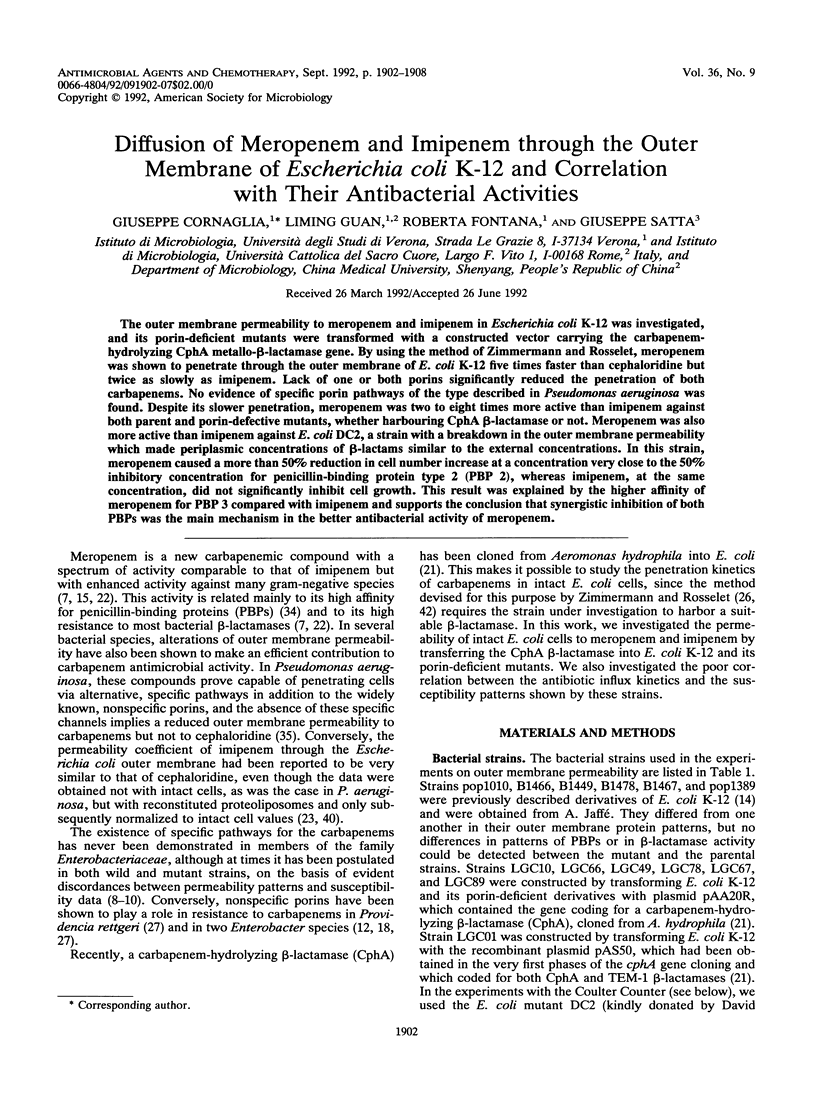
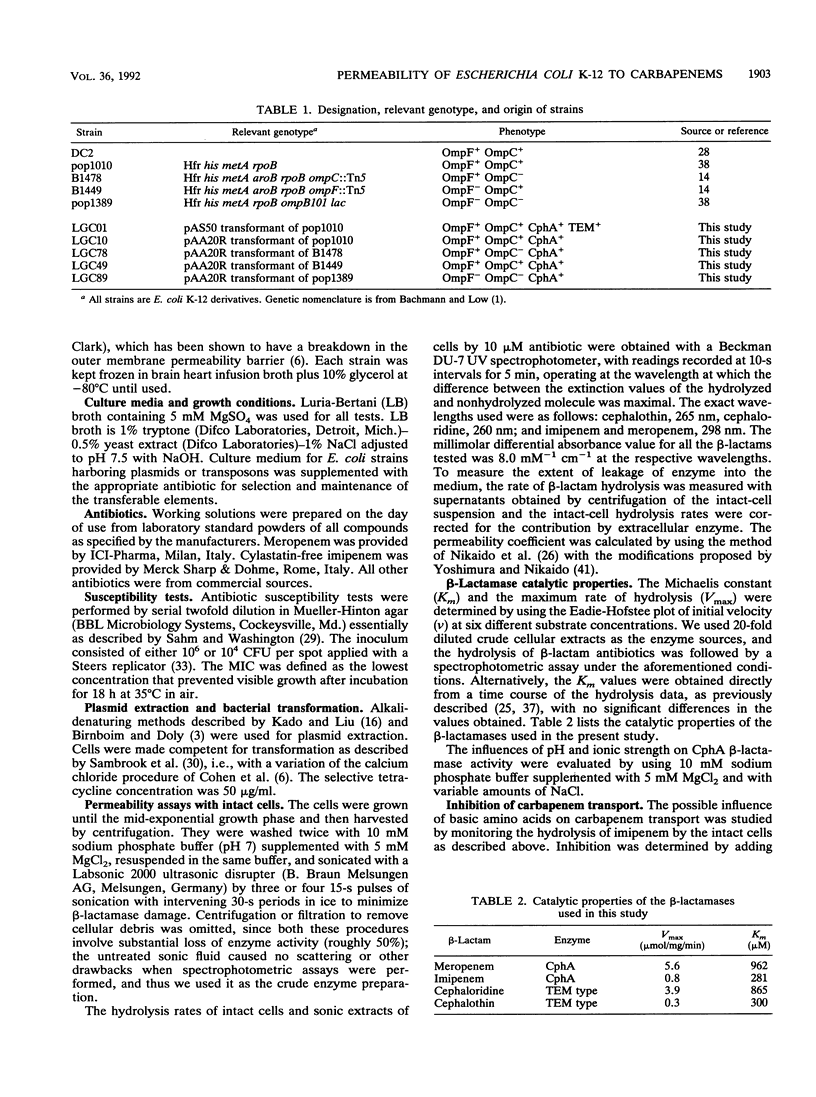
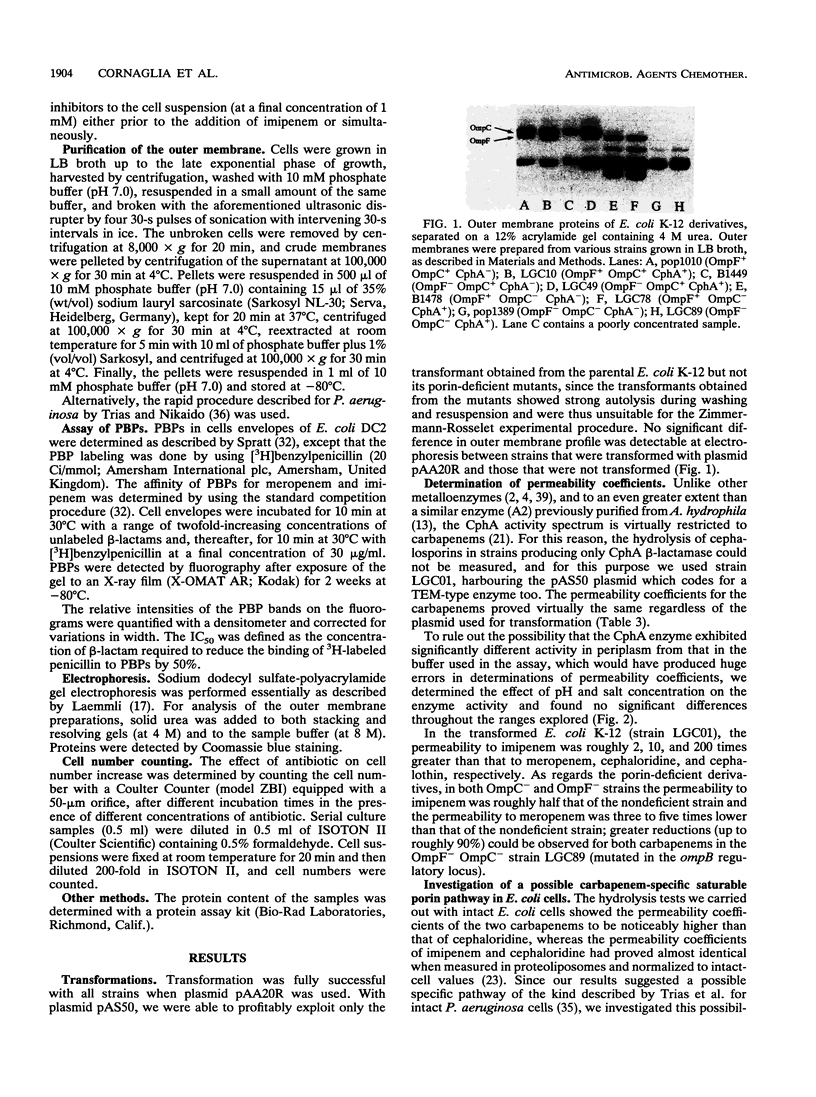
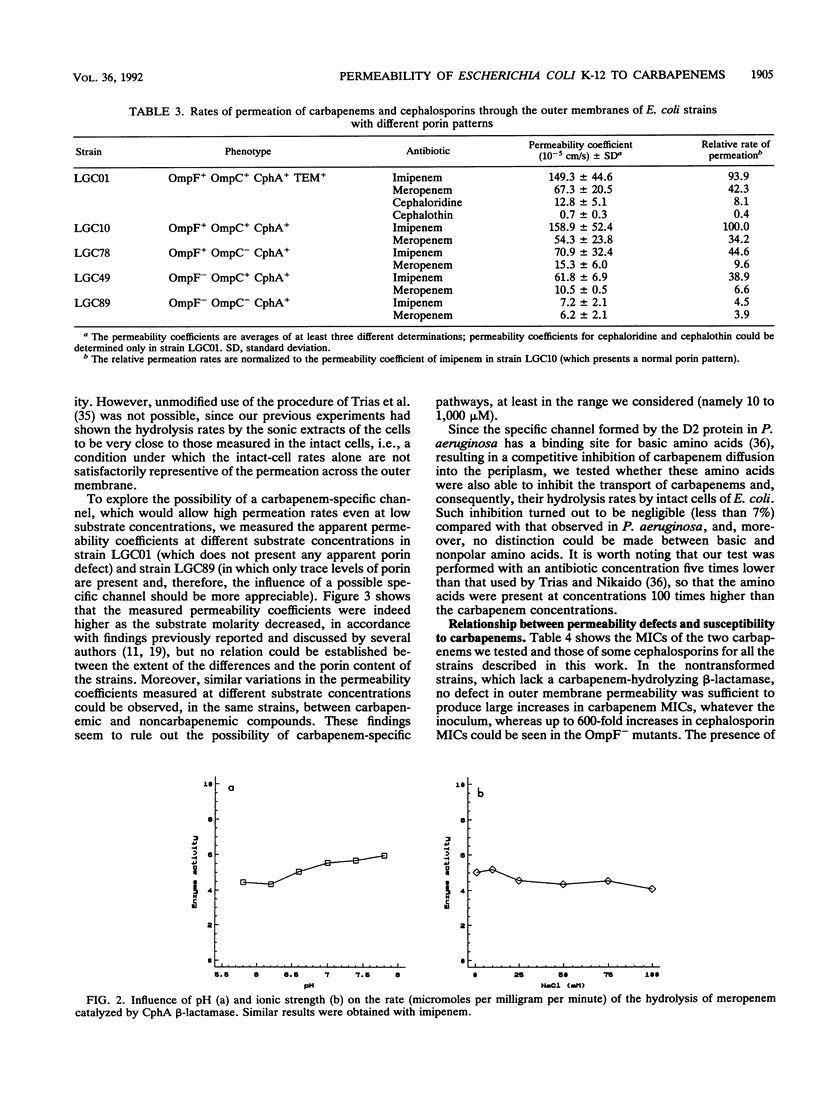
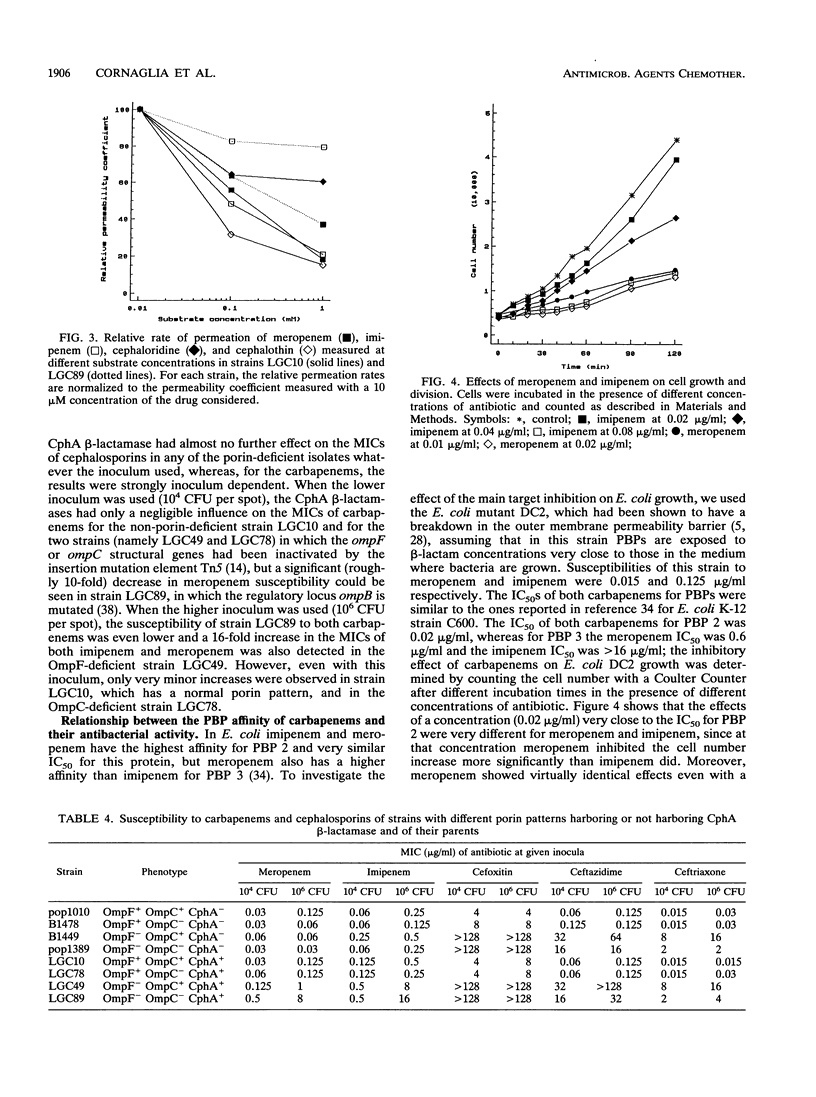
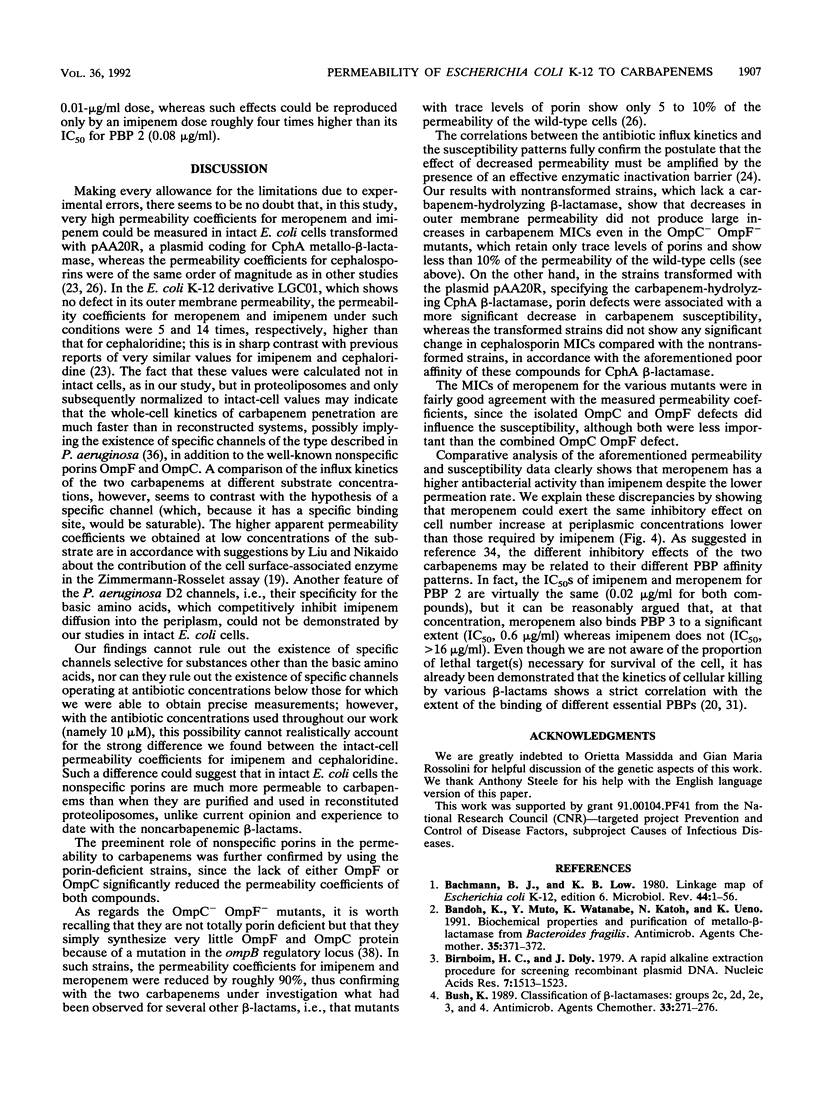
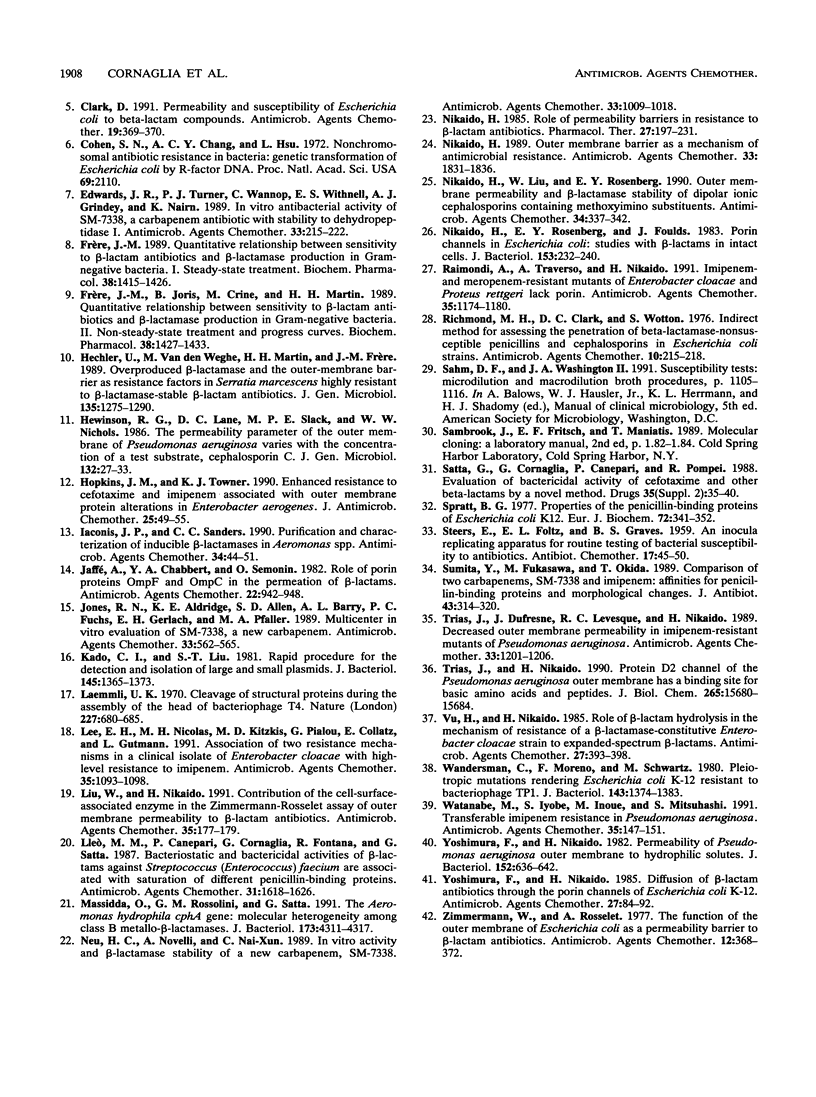
Images in this article
Selected References
These references are in PubMed. This may not be the complete list of references from this article.
- Bachmann B. J., Low K. B. Linkage map of Escherichia coli K-12, edition 6. Microbiol Rev. 1980 Mar;44(1):1–56. doi: 10.1128/mr.44.1.1-56.1980. [DOI] [PMC free article] [PubMed] [Google Scholar]
- Bandoh K., Muto Y., Watanabe K., Katoh N., Ueno K. Biochemical properties and purification of metallo-beta-lactamase from Bacteroides fragilis. Antimicrob Agents Chemother. 1991 Feb;35(2):371–372. doi: 10.1128/aac.35.2.371. [DOI] [PMC free article] [PubMed] [Google Scholar]
- Birnboim H. C., Doly J. A rapid alkaline extraction procedure for screening recombinant plasmid DNA. Nucleic Acids Res. 1979 Nov 24;7(6):1513–1523. doi: 10.1093/nar/7.6.1513. [DOI] [PMC free article] [PubMed] [Google Scholar]
- Bush K. Classification of beta-lactamases: groups 2c, 2d, 2e, 3, and 4. Antimicrob Agents Chemother. 1989 Mar;33(3):271–276. doi: 10.1128/aac.33.3.271. [DOI] [PMC free article] [PubMed] [Google Scholar]
- Clark D. Permeability and susceptibility of Escherichia coli to beta-lactam compounds. Antimicrob Agents Chemother. 1981 Feb;19(2):369–370. doi: 10.1128/aac.19.2.369. [DOI] [PMC free article] [PubMed] [Google Scholar]
- Cohen S. N., Chang A. C., Hsu L. Nonchromosomal antibiotic resistance in bacteria: genetic transformation of Escherichia coli by R-factor DNA. Proc Natl Acad Sci U S A. 1972 Aug;69(8):2110–2114. doi: 10.1073/pnas.69.8.2110. [DOI] [PMC free article] [PubMed] [Google Scholar]
- Edwards J. R., Turner P. J., Wannop C., Withnell E. S., Grindey A. J., Nairn K. In vitro antibacterial activity of SM-7338, a carbapenem antibiotic with stability to dehydropeptidase I. Antimicrob Agents Chemother. 1989 Feb;33(2):215–222. doi: 10.1128/aac.33.2.215. [DOI] [PMC free article] [PubMed] [Google Scholar]
- Frère J. M., Joris B., Crine M., Martin H. H. Quantitative relationship between sensitivity to beta-lactam antibiotics and beta-lactamase production in gram-negative bacteria--II. Non-steady-state treatment and progress curves. Biochem Pharmacol. 1989 May 1;38(9):1427–1433. doi: 10.1016/0006-2952(89)90181-0. [DOI] [PubMed] [Google Scholar]
- Frère J. M. Quantitative relationship between sensitivity to beta-lactam antibiotics and beta-lactamase production in gram-negative bacteria--I. Steady-state treatment. Biochem Pharmacol. 1989 May 1;38(9):1415–1426. doi: 10.1016/0006-2952(89)90180-9. [DOI] [PubMed] [Google Scholar]
- Hechler U., van den Weghe M., Martin H. H., Frère J. M. Overproduced beta-lactamase and the outer-membrane barrier as resistance factors in Serratia marcescens highly resistant to beta-lactamase-stable beta-lactam antibiotics. J Gen Microbiol. 1989 May;135(5):1275–1290. doi: 10.1099/00221287-135-5-1275. [DOI] [PubMed] [Google Scholar]
- Hewinson R. G., Lane D. C., Slack M. P., Nichols W. W. The permeability parameter of the outer membrane of Pseudomonas aeruginosa varies with the concentration of a test substrate, cephalosporin C. J Gen Microbiol. 1986 Jan;132(1):27–33. doi: 10.1099/00221287-132-1-27. [DOI] [PubMed] [Google Scholar]
- Hopkins J. M., Towner K. J. Enhanced resistance to cefotaxime and imipenem associated with outer membrane protein alterations in Enterobacter aerogenes. J Antimicrob Chemother. 1990 Jan;25(1):49–55. doi: 10.1093/jac/25.1.49. [DOI] [PubMed] [Google Scholar]
- Iaconis J. P., Sanders C. C. Purification and characterization of inducible beta-lactamases in Aeromonas spp. Antimicrob Agents Chemother. 1990 Jan;34(1):44–51. doi: 10.1128/aac.34.1.44. [DOI] [PMC free article] [PubMed] [Google Scholar]
- Jaffe A., Chabbert Y. A., Semonin O. Role of porin proteins OmpF and OmpC in the permeation of beta-lactams. Antimicrob Agents Chemother. 1982 Dec;22(6):942–948. doi: 10.1128/aac.22.6.942. [DOI] [PMC free article] [PubMed] [Google Scholar]
- Jones R. N., Aldridge K. E., Allen S. D., Barry A. L., Fuchs P. C., Gerlach E. H., Pfaller M. A. Multicenter in vitro evaluation of SM-7338, a new carbapenem. Antimicrob Agents Chemother. 1989 Apr;33(4):562–565. doi: 10.1128/aac.33.4.562. [DOI] [PMC free article] [PubMed] [Google Scholar]
- Kado C. I., Liu S. T. Rapid procedure for detection and isolation of large and small plasmids. J Bacteriol. 1981 Mar;145(3):1365–1373. doi: 10.1128/jb.145.3.1365-1373.1981. [DOI] [PMC free article] [PubMed] [Google Scholar]
- Laemmli U. K. Cleavage of structural proteins during the assembly of the head of bacteriophage T4. Nature. 1970 Aug 15;227(5259):680–685. doi: 10.1038/227680a0. [DOI] [PubMed] [Google Scholar]
- Lee E. H., Nicolas M. H., Kitzis M. D., Pialoux G., Collatz E., Gutmann L. Association of two resistance mechanisms in a clinical isolate of Enterobacter cloacae with high-level resistance to imipenem. Antimicrob Agents Chemother. 1991 Jun;35(6):1093–1098. doi: 10.1128/aac.35.6.1093. [DOI] [PMC free article] [PubMed] [Google Scholar]
- Liu W., Nikaido H. Contribution of the cell-surface-associated enzyme in the Zimmermann-Rosselet assay of outer membrane permeability of beta-lactam antibiotics. Antimicrob Agents Chemother. 1991 Jan;35(1):177–179. doi: 10.1128/aac.35.1.177. [DOI] [PMC free article] [PubMed] [Google Scholar]
- Lleó M. M., Canepari P., Cornaglia G., Fontana R., Satta G. Bacteriostatic and bactericidal activities of beta-lactams against Streptococcus (Enterococcus) faecium are associated with saturation of different penicillin-binding proteins. Antimicrob Agents Chemother. 1987 Oct;31(10):1618–1626. doi: 10.1128/aac.31.10.1618. [DOI] [PMC free article] [PubMed] [Google Scholar]
- Neu H. C., Novelli A., Chin N. X. In vitro activity and beta-lactamase stability of a new carbapenem, SM-7338. Antimicrob Agents Chemother. 1989 Jul;33(7):1009–1018. doi: 10.1128/aac.33.7.1009. [DOI] [PMC free article] [PubMed] [Google Scholar]
- Nikaido H., Liu W., Rosenberg E. Y. Outer membrane permeability and beta-lactamase stability of dipolar ionic cephalosporins containing methoxyimino substituents. Antimicrob Agents Chemother. 1990 Feb;34(2):337–342. doi: 10.1128/aac.34.2.337. [DOI] [PMC free article] [PubMed] [Google Scholar]
- Nikaido H. Outer membrane barrier as a mechanism of antimicrobial resistance. Antimicrob Agents Chemother. 1989 Nov;33(11):1831–1836. doi: 10.1128/aac.33.11.1831. [DOI] [PMC free article] [PubMed] [Google Scholar]
- Nikaido H. Role of permeability barriers in resistance to beta-lactam antibiotics. Pharmacol Ther. 1985;27(2):197–231. doi: 10.1016/0163-7258(85)90069-5. [DOI] [PubMed] [Google Scholar]
- Nikaido H., Rosenberg E. Y., Foulds J. Porin channels in Escherichia coli: studies with beta-lactams in intact cells. J Bacteriol. 1983 Jan;153(1):232–240. doi: 10.1128/jb.153.1.232-240.1983. [DOI] [PMC free article] [PubMed] [Google Scholar]
- Raimondi A., Traverso A., Nikaido H. Imipenem- and meropenem-resistant mutants of Enterobacter cloacae and Proteus rettgeri lack porins. Antimicrob Agents Chemother. 1991 Jun;35(6):1174–1180. doi: 10.1128/aac.35.6.1174. [DOI] [PMC free article] [PubMed] [Google Scholar]
- Richmond M. H., Clark D. C., Wotton S. Indirect method for assessing the penetration of beta-lactamase-nonsusceptible penicillins and cephalosporins in Escherichia coli strains. Antimicrob Agents Chemother. 1976 Aug;10(2):215–218. doi: 10.1128/aac.10.2.215. [DOI] [PMC free article] [PubMed] [Google Scholar]
- Satta G., Cornaglia G., Canepari P., Pompei R. Evaluation of bactericidal activity of cefotaxime and other beta-lactams by a novel method. Drugs. 1988;35 (Suppl 2):35–40. doi: 10.2165/00003495-198800352-00009. [DOI] [PubMed] [Google Scholar]
- Spratt B. G. Properties of the penicillin-binding proteins of Escherichia coli K12,. Eur J Biochem. 1977 Jan;72(2):341–352. doi: 10.1111/j.1432-1033.1977.tb11258.x. [DOI] [PubMed] [Google Scholar]
- Sumita Y., Fukasawa M., Okuda T. Comparison of two carbapenems, SM-7338 and imipenem: affinities for penicillin-binding proteins and morphological changes. J Antibiot (Tokyo) 1990 Mar;43(3):314–320. doi: 10.7164/antibiotics.43.314. [DOI] [PubMed] [Google Scholar]
- Trias J., Dufresne J., Levesque R. C., Nikaido H. Decreased outer membrane permeability in imipenem-resistant mutants of Pseudomonas aeruginosa. Antimicrob Agents Chemother. 1989 Aug;33(8):1202–1206. doi: 10.1128/aac.33.8.1202. [DOI] [PMC free article] [PubMed] [Google Scholar]
- Trias J., Nikaido H. Protein D2 channel of the Pseudomonas aeruginosa outer membrane has a binding site for basic amino acids and peptides. J Biol Chem. 1990 Sep 15;265(26):15680–15684. [PubMed] [Google Scholar]
- Vu H., Nikaido H. Role of beta-lactam hydrolysis in the mechanism of resistance of a beta-lactamase-constitutive Enterobacter cloacae strain to expanded-spectrum beta-lactams. Antimicrob Agents Chemother. 1985 Mar;27(3):393–398. doi: 10.1128/aac.27.3.393. [DOI] [PMC free article] [PubMed] [Google Scholar]
- Wandersman C., Moreno F., Schwartz M. Pleiotropic mutations rendering Escherichia coli K-12 resistant to bacteriophage TP1. J Bacteriol. 1980 Sep;143(3):1374–1383. doi: 10.1128/jb.143.3.1374-1383.1980. [DOI] [PMC free article] [PubMed] [Google Scholar]
- Watanabe M., Iyobe S., Inoue M., Mitsuhashi S. Transferable imipenem resistance in Pseudomonas aeruginosa. Antimicrob Agents Chemother. 1991 Jan;35(1):147–151. doi: 10.1128/aac.35.1.147. [DOI] [PMC free article] [PubMed] [Google Scholar]
- Yoshimura F., Nikaido H. Diffusion of beta-lactam antibiotics through the porin channels of Escherichia coli K-12. Antimicrob Agents Chemother. 1985 Jan;27(1):84–92. doi: 10.1128/aac.27.1.84. [DOI] [PMC free article] [PubMed] [Google Scholar]
- Yoshimura F., Nikaido H. Permeability of Pseudomonas aeruginosa outer membrane to hydrophilic solutes. J Bacteriol. 1982 Nov;152(2):636–642. doi: 10.1128/jb.152.2.636-642.1982. [DOI] [PMC free article] [PubMed] [Google Scholar]
- Zimmermann W., Rosselet A. Function of the outer membrane of Escherichia coli as a permeability barrier to beta-lactam antibiotics. Antimicrob Agents Chemother. 1977 Sep;12(3):368–372. doi: 10.1128/aac.12.3.368. [DOI] [PMC free article] [PubMed] [Google Scholar]



